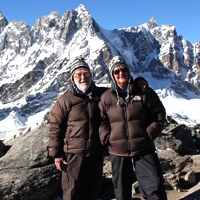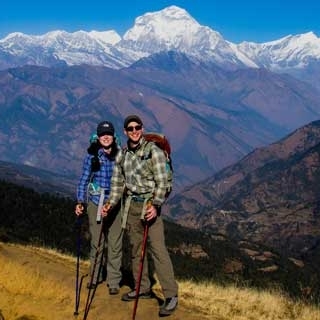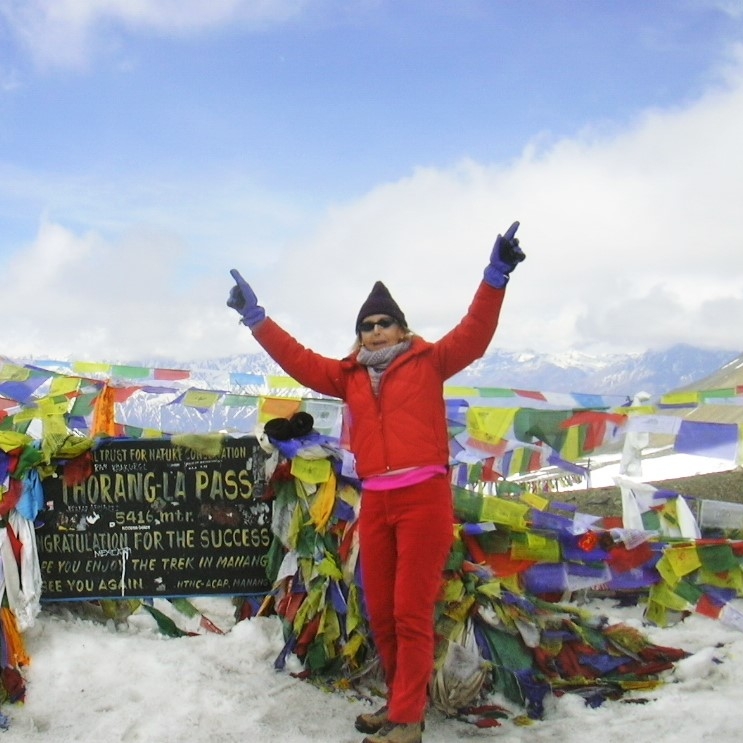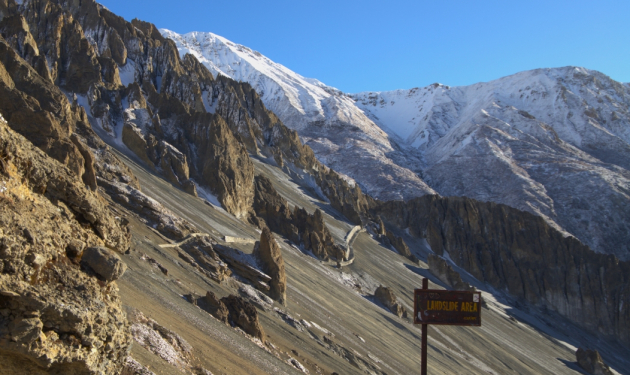Annapurna Base Camp Trekking is one of the best trekking areas in the world, lying in the Annapurna Conservation Area of Nepal. The word Annapurna is a Sanskrit name that literally means “full of food” but is normally translated as Goddess of the Harvests. The Annapurna region is a majestic section of the Himalayas in Nepal.
Commencing with an overland journey to Beshi Sahar, 130 km west of Kathmandu, where we overnight. Our trek follows the gorge of the Marshyangdi River through lush fields of paddy, innumerable tiny streams, waterfalls, and beautiful villages, eventually emerging into the high desert country at Manang (3597 m). It lies close to the Northern massif of Annapurna, where the World's high altitude lake Tilicho 4,919 metres (16,138 ft) is situated.
The Annapurna circuit trek gains in height fairly gently, reducing the chances of altitude sickness, although, we do spend a day acclimatizing before crossing the Thorong-La Pass (5,416 m). From a high lodge camp, we are up early for our crossing of the Thorong-La pass (tremendous high mountain feelings) before our descent to Muktinath in the lower Mustang region, one of the holiest pilgrimage sites for Buddhist and Hindu people in Nepal.
We continue through the dry, arid landscape to Kagbeni, a fascinating historical fortress town. The trail back follows the Kali Gandaki River to Jomsom (optional fly out here) beneath the shadow of immense Himalayan peaks and through the deepest canyon in the world. We descend to Tatopani before ascending to Ghorepani and Poon Hill for some tremendous sunrise views of both the Dhaulagiri and Annapurna Himalayas.
A further two days are spent trekking through the beautiful Rhododendron, bamboo, and oak forest in Annapurna trekking rout. Before eventually reaching Nayapul for a short drive to the beautiful lakeside town of Pokhara. This Annapurna Circuit trek is considered to be the classic trek in Nepal to experience the vast biodiversity and cultural heritage Nepal is renowned for. Annapurna Circuit Trekking is the most important and famous trekking area in the Annapurna region and the right adventure for those seeking solace in the isolated and remote villages of Annapurna, chasing the spectacular views of the Annapurna massif.
What is less known about Annapurna circuit trek is that Annapurna, means "full of food" Mata Annapurni of Hindu religion resembless goddess of food. Hence, you can taste numerous regional cusines in Annapurna trekking trail, with ginger garlic soup, coffee, traditional style wine, thukpa, theknag, and traditional Dal Bhat.
Day 01: Drive Kathmandu / Besisahar (760 m, 2493 ft)—approximately 6 hours drive
Day 02: Besisahar / Bahun Danda (1310 m, 4298 ft) – 5 hrs walk
Day 03: Bahun Danda / Chamje (1430 m, 4692 ft) – 6 hrs walk
Day 04: Chamje / Dharapani (1860 m, 6102 ft) – 6 hrs walk
Day 05: Dharapani / Chame (2670 m, 8760 ft) – 5 hrs walk
Day 06: Chame / Pisang (3200 m, 10499 ft) – 6 hrs walk
Day 07: Pisang / Manang (3540 m, 11614 ft) – 4 hrs walk
Day 08: Rest at Manang. Stroll around at Manang.
Day 09-10: Manang / Yak Kharka (4018 m, 13182 ft) / Thorang Phedi (4450 m, 14600 ft)
Day 11: Thorang phedi / Thorang pass (5416 m, 17770 ft) descend to Muktinath (3800 m, 12467 ft) – 8 hrs walk
Day 12: Muktinath / Tatopani (1190 m, 3904 ft) – 3 hrs drive)
Day 13: Tatopani / Shikha (1935 m, 6348 ft) / Ghorepani (2750 m, 9022 ft) – 8 hrs
Day 14: Ghorepani / Ghandruk (1940 m, 6365 ft) – 7 hrs walk
Day 15: Ghandrunk / Nayapul (1900 m, 6234 ft) / Pokhara – 4 hours walk and 1-hour drive
Day 16: Drive back to Kathmandu (1350 m, 4430 ft) - 7 hours
In the Annapurna region, your Circuit Trek begins through the villages of Annapurna, Ngadi, Chamje, Dharapani, Chame, Pisang, Manang, Yak Kharka, Phedi, and Jomsom, while you return to Pokhara after circuit exploration of Annapurna, (8,091 m)
The best season and most favored time for the Annapurna Circuit Trek (Round Annapurna) is autumn (from September to November) and spring (from March to May). During this period the daytime is sunny and warm, with outstanding views. At this time, the temperature is between 10 and 30 °C. The nights are often cold, with a temperature between 5 °C and 20 °C.
Trekking in Annapurna roundtrip brings challenges in winter (Dec, Jan, Feb) is also possible, but the temperature during the winter could be harsh for most people. Trekking in summer (June, July, and August) will be affected by rain/monsoon but the summer trek could be an advantage for a keen botanist. For safe navigation in season and off-season carry Annapurna Circuit Trek map, updated for 2024/25. The trekking routes may be altered due to rocky trail or landslides, at times. If you are early before season, you will be one of the few groups trekking in Annapurna which makes navigation more fun, but risky at the same time. You can contact us for life time memorable. Enquiry now.
After breakfast, you will drive to Besisahar (approx. 185 km), which takes about 6 hours. You will drive past beautiful landscapes. Overnight at guest house/lodge.



Todays trek begins to introduce us to the many cultural elements of Nepal. You will come across typical houses and the different faces of the local people, exchanging greetings as we pass. Crossing the suspension bridge at Besisahar to the eastern side of the Marshyangdi River and climb up the trail. The trail has a mix of ascent and decent as we pass small valleys, the mix of Nepali people is clearly seen in the faces of the local people we meet as we pass through the villages. Nadi is a settlement of families originally from Manang village while Taranche, immediately above it, is a Gurung village. The last hour and half we climb uphill to reach Bahun Danda, where we stay overnight.



From Bahun Danda we gain slight altitude to reach Chamje. Drop down fro the ridge on which Bahundanda is perched and follow the river to Syange, where we cross the river by suspension bridge. From here we climb uphill for about an hour to the village of Jagat, there are some great views of the river below as well as of the waterfall across the river. Chamje is another hour and half following the river.



The route today passes villages and local communites that are said to have migrated from Tibet a long time ago. As we trek you will feel the difference in the lifestyle of the people and their settlements. We cross the suspension bridge below Chamje and climb two steep sections of the trail to reach the village of Tal. Tal is populated with Gurungs and Tibetans. From the end of the valley above Tal, the trail rises steeply initially and then rises and falls as it cuts across the mountain side to Dharapani.



Today the trail mostly climbs as we increase in altitude, you will find that even though we are not walking for that long each day, you do consume a lot of energy. We reach Bagarchap, a Tibetan village, within the first hour of todays trek, followed by Dangyung, a small Tibetan settlement shortky afterwards. We then enter dense forest, cross bridges over tributaries and at the foot of a waterfall ascend steep stone steps to reach the new trail to Chame. It will take us about 3 and half hours with some fine views of Annapurna II on the approach to Chame.



Today’s walk passes several rivers and so we climb up and down between them. From Chame, we reach the small settlement of Taleku, in approximately forty minutes. In just under two hours, we cross a bridge to the sparsely inhabited settlement of Bartang. This former Khampa settlement is now an orchard and marks the traditional boundary between the Manang area to the north and the predominantly Gurung area to the south. From Bartang, we follow the river for forty-five minutes, cross the bridge and then ascend to the floor of the Manang valley and Lower Pisang. A spectacular rockwall is in view for much of the climb. You will notice a real change in the landscape as the area becomes much more arid as we climb.



The trail continues to climb and by now, you will be encountering the windy and dry atmosphere of the area. This is one of the reasons that makes Manang a special place of interest for the visitors. The trail rises, first gradually and then more steeply from Lower Pisang to reach the crest of a ridge overlooking the upper Manang Valley. The airfield and settlement area of Ongre are clearly visible from this vantage-point. We then head down to the flat valley floor and reach Ongre, shortly after this we cross the Sabche Khola River with a great view of the amphitheatre formed by Annapurna III and IV. Watch out for the village of Braga, built impressively into a cliff-wall. Manang is about half an hour past Braga.



Today will be day for acclimatization, allowing our bodies a chance to adjust to our increase in height. We will make some short hikes around the area during the day.



The way slowly ascends through the Manang village. The houses are mad by clay and stone and joint each other. The path keeps on going up slowly by crossing the innumerable tiny streams, which come from the Chulu east and Chulu west.



Today we head to the foot of Thorong La pass, Thorong Phedi. From Yak Kharka, we will climb up to a ridge, then head down and cross the Marsyangdi river on a wooden bridge. After climbing up the mountain, we follow a narrow trail across a slope and descend to Thorung Phedi. The uninhabited, rugged terrain is otherworldly and much different than the lush lowlands that we passed on the way up during the initial phase of the trek.



Today is the biggest challenge, a long day as we start early to ascend to the Thorong La Pass. It usually takes around 7 hrs to complete the climb, before a 3 hr decent to Muktinath. The views of the Himalaya are magnificent as you climb up and cross this popular pass, don’t forget to look at the views ! Muktinath is a pilgrimage centre for both Buddhists and Hindus, it is home to the Vishnu temple of Jiwala Mayi as well as several Buddhist monasteries. It is believed that all your sins are relieved when visiting this temple of Lord Vishnu. In an old temple you can find the natural spring and natural gas jets which produce the eternal flame of Muktinath, it is this combination of earth- water -fire that gives the area its particular religious significance.



In the morning, we visit Muktinath Temple and then continue our journey on a local bus ride to Tatopani. It will be a rough drive as the road passes through some of the deepest gorges in the world. We will be moving from the arid highlands to lush green forests. Tatopani is famous for natural hot springs, and it is a place where we can immerse ourselves in the hot springs and relax. The waters of Tatopani are said to have curative properties against skin diseases.



Again cross the long suspension bridge over the Kali Gandaki then again Do Khola (stream) the path goes rapidly up via Ghara and Shikha villages. You will gain about 1500m high today. The stunning view of Mt. Dhaulagiri is just in front of you. Keep continue to uphill trek through thick, lush Rhododendron forest. In spring season, the place looks like a heaven, when the Rhododendron is in bloom. Ghorepani is one of the magnificent villages in the area. A good place to see owe inspiring view of Annapurna and Dhaulagiri massive.



Early in the morning, we will climb for one hour to the top of Poon Hill. Poon Hill is one of the most popular vantage points of this trek, it is situated at an elevation of 3210m. From here we can see the tremendous views of Dhaulagiri and the Annapurna range. After enjoying the views for a while, we return to Ghorepani village and after breakfast start our trek to Ghandruk.
The trail climbs south on path through deep forests. It finally emerges on a grassy knoll which offers good mountain views, including a view of Machhapuchhare (not visible from Ghorepani) and a panorama all the way south to the plains of India. It is a similar view to that from Poon Hill. We climb along the ridge in pine and rhododendron forests to a crest at 3030m, then descend to cross a second pass, at 2960m. The trail then descends steeply to a stream before the climbing again through the forest to Tadapani. The trail descends steeply from Tadapani through the forest to a clearing, a short steep descent among rocks leads to a stream crossing then we descend gently pass other streams and finally down towards Ghangdruk. The trail reaches the edge of Ghangdruk near the tin roofed handicraft factory, and then descends on stone steps into the maze of the village itself.



The remainder of the trek is gradual downhill through the village of syauli Bazar. It takes about two hours to reach syauli bazar. then after countinue to get Birethati. Birethati is the exit point of the ACAP region and foreigners need to check out here. Nayapul is connected to the highway by a graveled road with some jeeps offering a ride to Pokhara and it is in the Bhupi Sherchan Highway (Pokhara to Baglung). From here we take our taxi and drive back to Pokhara.



Your Annapurna Circuit Package ends today. We wake up in Pokhara this day, and after breakfast, we drive back to Kathmandu on a tourist bus. It's a 200 km route that initially follows the Marsyangdi River and Trishuli River later. You may also choose to return by a 25-minute flight (not included in the package) from Pokhara. Our trek package completes at Kathmandu.



Annapurna Circuit Trekking is moderate trek suitable for any passionate walkers who able to walk at least 5-7hours a day with a light day pack. Walking in higher altitudes is more physically demanding than walking in lower altitudes; however, if you are in excellent health with average physical fitness and have a positive attitude, self-confidence, and strong determination, you can do this trek successfully. Exercising and jogging regularly for some weeks prior to the trip is a good idea to enhance your strength and stability. Past hiking experience would be an asset but no compulsorily required for this trip. It is vital for participants with pre-existing medical conditions such as heart, lung, and blood diseases to consult their doctor before taking the trip.
The cost of the Annapurna Circuit Trek depends on the package and services included the cost is $1750
The best time to go on Annapurna Circuit Trek is during the Autumn season (September and November) it offers clear skies comfortable temperatures and great visibility of peaks and surroundings.
The most popular route for the Annapurna circuit trek starts from Besishar or Bhulbhule and finishes in Jomsom this route is considered as traditional route.
It was our genuine pleasure to make comments about your excellent firm – we are genuinely full of praise for the services you offer. As promised we attach some photos taken of high points of our trip, most with Karma and / or Nima. Please feel free to use any that you wish

Hi Bishnu, First of all, Sivan and I would like to say a tremendous thank you for all of the support in making our visit to Nepal a tremendous success. We had an absolutely amazing time, our guides and your staff were all first rate; and the hotels and logistics all went incredibly smoothly. We were only sorry that we could not arrange to spend some time with you and visit the Children’s Centre, I guess it will have to wait for our next visit (which we both said must happen as soon as possible!) The day after our trek, I met a lady called Katherine who told me she’s interested in doing a similar kind of trek, so I offered to put the two of you in touch (cc’d). Thank you very much, Joshua Simons and Katherine Burnett Threadneedle Street, London EC2R 8AH. England December 29, 2016

A couple of days ago I returned from Kathmandu totally touched by the wonderful trek I have just done, the Annapurna Circuit Trek, called “the mother of all treks”. It is approximately 22 days trek depending on the physical and mental strength of each trekker, but in general it is an affordable route for all types of people and highly recommended for lovers of High Mountain. Keep in mind that crossing the hightest pass of the world, the Throng La Pass (5,416 m.) requires a lot of effort, spirit of sacrifice and a correct acclimatization. When ascending from Besisahar to 760 m. above sea level up to 5,416 m. and then descend again to Nayapul at 1070 m. the landscape changes drastically during the whole route. It runs between small villages with their lodges and starts and ends in the tropical jungle with the monkeys watching as you move along the narrow path and its stone stairs. From there the road continue through the forest until you reach the desert and rocky places more like Mars than anything else, as well as the valley of the huge and wide Kali Gandaki river, surrounded by the immense snow mountains, Annapurna 8,091 m., Dhaulagiri 8,167 m. and Nilgiri 7,145 m. I was accompanied at all times by my guide Umesh and by Omar, the porter the Nature Trail agency has provided me, and I have to thank with all my heart Umesh and Omar for their constant company, assistance and unconditional support that they gave me during all the trekking, as well as their sympathy and care, without whom this extraordinary journey would not have been possible. It has been an immensely gratifying experience thanks to the professionalism of Nature Trail agency. Cora Teschendorff Av. Menendez y Pelayo nr. 9, 7A, Spain Annapurna Circuit Trek



Discover incredible offers for your upcoming adventure by subscribing to our newsletter with the latest travel tips and updates.
